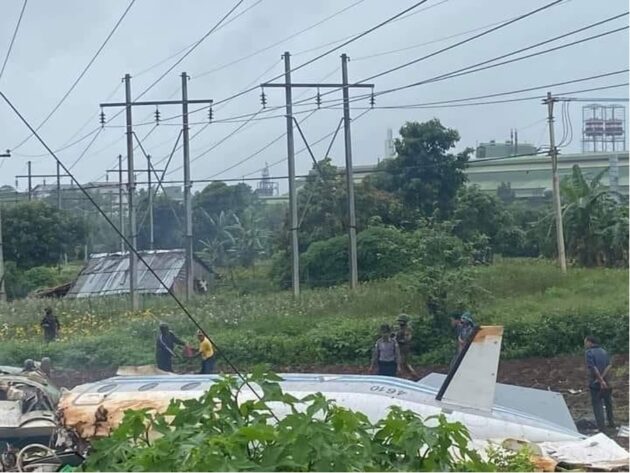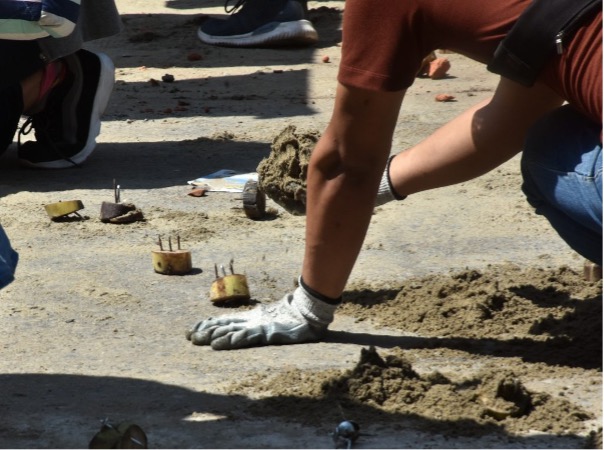10th June 2021
The guerrilla rearguard action is gradually picking up pace. There have been comments that there is no leadership of the movement, but that is a deliberate decision. They have learned from the Hong Kong dissenters and form small cells of independent activists. Whilst this means that there are sometimes uncoordinated activities, it also limits the damage to the movement if the Junta penetrate one cell. As it grows then informal contacts are being developed, especially as people are meeting in training camps in the ethnic conflict zones.
Just breaking, there has been a plane crash in Mandalay region.

The plane was flying from the capital, Naypyidaw, to the town of Pyin Oo Lwin on Thursday and was coming in to land when it crashed about 300 metres (984 feet) from a steel plant, the military-owned Myawaddy television station reported. Zaw Min Tun, a spokesman for Myanmar’s military, said the plane had “lost communications” during bad weather.
Emergency workers were still on the scene, he added.
The plane was carrying six military personnel and also monks who were due to attend a ceremony at a Buddhist monastery, other media reports said.
Among the victims was one of Myanmar’s most influential Buddhist monks – Abhisheka Maha Rattha Guru Bhatanda Kavisara, according to the Irrawaddy news website. The monk is venerated by the Myanmar military, it reported.
A second monk, two lieutenant commanders and two captains also died, Irrawaddy said.
There were no reports of casualties among people on the ground.
The pilot and one passenger survived and were taken to a military hospital, according to a resident and posting by a community group.
Other than bad weather, the cause of the crash has not been disclosed, but last month, the Kachin Independence Army downed an army helicopter during fierce clashes.
Source Al Jazeera 10th June 2021.
In the immediate aftermath of the February 1 coup, Ko Min Wai was a staunch supporter of peaceful protests.
But when the security forces began brutally crushing demonstrations in March, the 26-year-old engineering graduate and some friends resolved to take the fight up to the Tatmadaw.
“We can’t protest on the street because the army and security forces shoot us with real bullets. But we must revolt against the junta, so we choose armed revolution,” Min Wai told Frontier on May 24, asking not to reveal his real name for safety reasons.
That month, he and his friends travelled from Yangon to an area under the control of an ethnic armed group and underwent a month of military training. A total of 50 young people participated in the course, he said.
Now back in Yangon, Min Wai and other members of his 10-person group are waging what they call “guerrilla warfare” in the commercial capital. They have planted hand grenades at barracks for police and soldiers as well as in government offices.
“I learned how to fight using explosives and guns. Then we returned to Yangon to attack the junta’s army,” he said. “We used hand-made bombs to attack soldiers in some townships in May. We have carried out three missions in Yangon.”
In response to the rising casualty toll from the disproportionate use of force by soldiers and police, many young people like Min Wai began to consider spurning non-violent protests in favour of more active forms of resistance. Hundreds, if not thousands, of young people have fled to border areas under the control of ethnic armed groups to receive military training.
Although peaceful protests continue to be held, often as flash mobs to minimise the risk of arrest, assassinations and bombings have become more common across the country, particularly since the start of May.
U Aung Myo Min, the NUG’s minister for human rights, said the military was “pushing the youth to take up arms” through its violence. “The military has used weapons to crackdown on peaceful protests. So, the young people have made a choice and they are going to fight back,” he said.
These attacks are usually carried out by secretive groups that sometimes label themselves as “UG”, an abbreviation for “underground”. In one such incident, three members of the hardline pro-military group known as Pyusawhti were killed in a shootout in Sagaing Region’s Mingin Township on June 3 with members of Nalseemachar Moegyo Mhone Tine, or Thunderstorms-Without-Borders, a protection force established by township residents that is allied with but not under the direction of the Mingin branch of the People’s Defence Force.
In Yangon, small, independent guerrilla groups like Min Wai’s have added yet another dimension to the already complex cast of armed actors resisting the coup. These groups, which have no affiliation with the National Unity Government or ethnic armed groups, have demonstrated a willingness to use asymmetrical warfare and non-conventional tactics to achieve their goals.
Interviews by Frontier indicate that there are at least 10 urban guerrilla outfits operating in the country’s main cities.
Radio Free Asia has reported that there have been more than 300 bombings in Myanmar since the coup. Scores of these attacks targeted state schools in the lead-up to the resumption of classes on June 1.
In Yangon Region, independent media outlets have reported bomb attacks in Sanchaung, Yankin, Hlaing Tharyar, Thaketa, Hlaing, and South and North Dagon townships. Many of the bombings occurred at night and targeted ward and township government offices, schools, universities, and petrol stations. A bomb exploded in the car park at the Makro supermarket in Mingalar Taung Nyunt Township on May 20 but caused no casualties. On May 22, one of three soldiers guarding a school in Tarmwe Township was killed when they were shot at by an unknown group, DVB News reported.
Min Wai said residents should expect more attacks.
“In the coming months, we will attack more soldiers and dalan (informers). Our revolution is starting,” he said.

As the death toll from guerrilla attacks slowly rises, security has been tightened at likely targets in Yangon, such as township General Administration Department offices and police stations.
But the attacks are also creating anxiety among the city’s residents.
“I am worried about the bomb explosions said one. I don’t know who they are working for,” he said. “If there is a bomb attack on a site used by the security forces and they die I am not concerned, but I worry about innocent bystanders being harmed by bombing in public places.”
NUG minister Aung Myo Min, who has urged the guerrilla groups to adhere to the code of conduct, which the NUG released on May 26. The code enjoins PDFs and other armed resistance groups to target only enemies and to avoid harming civilians, attacking religious buildings, schools and hospitals, and not to abuse women and children. “Whether it’s PDFs or not, all revolutionary groups must adhere to the code of conduct,” he said.
But Aung Myo Min acknowledged that ensuring compliance was going to be difficult. “There are too many groups, and they are not connected, so there is a high risk of the code being breached,” he said.
However, Min Wai said it was the military that was ignoring the rules of conflict.
“The military has deployed forces at schools and at universities and has opened fire from those locations,” he said, adding that his group was following the rules it learnt when it was being trained. “We are not the Myanmar military.”
Ko Htet Aung (not his real name), a 25-year-old guerrilla fighter in Yangon, said his group was determined to set its own standards. “We decide what we can do and how to carry out attacks. We devise our own strategy,” he said. “The guerrilla attacks will increase in the coming months.”
“We don’t want bombs, but we also cannot live under a military dictatorship,” he said. “I pray that civilians are not harmed too much.”
Source Frontier 9th June 2021.
And so, the resistance grows. If they survive a couple of months, then they will join with the NUG’s PDF forces and the Ethnic Armed Organisation to cause real trouble for the military. The Junta will then be involved in a full-scale guerrilla war with all the implications that has for the morale of the troops.
Please share this article so that others can discover The BFD
